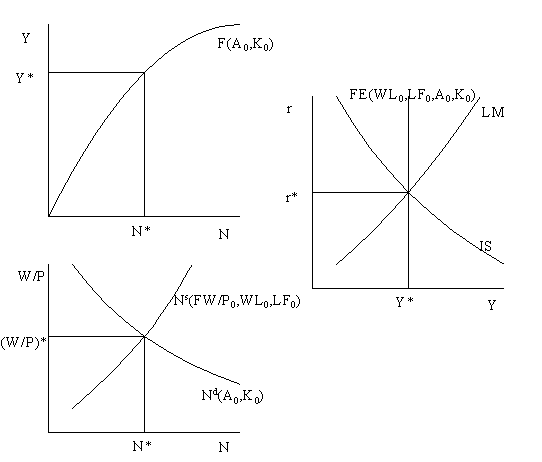
Reading: AB, chapter 10, sections 4 and 5.

The above three diagrams represent general equilibrium in the labor market (labor demand = labor supply), goods market (desired saving = desired investment) and money market (money demand = money supply). Supply is determined by the interaction between the labor market and the production function. Equilibrium in the labor market determines the equilibrium real wage (W/P)* and the level of employment N*. Given the equilibrium level of employment the production function gives full employment output Y*. In the IS/LM diagram, we represent the full employment output (aggregate supply) restriction by the vertical FE (full employment) line. The FE line is vertical because full employment output does not depend on the real interest rate (it is assumed that the labor market and the production function are independent of the real interest rate). Points on the FE line represent equilibrium in the labor market. Exogenous factors that shift either the production function, labor demand or labor supply change the equilibrium level of Y* and thus shift the FE line. Functionally, we represent the FE line as

Pluses over the variables indicate that increases in the variables increase full employment outpout.
The intersection of IS, LM and FE at (r*, Y*) means that the labor market, goods market and money markets are in general equilibrium. At these values of r and Y there are not forces acting to move the economy from the equilibrium. Starting from an initial general equilibrium (intersection of IS, LM and FE), if either the IS, LM or FE line shifts the economy moves out of general equilibrium. The classical assumption is that when the economy is out of general equilibrium the aggregrate price level, P, adjusts so that the economy can move back to general equilibrium. Notice that when P changes the LM curves shifts. Thus the classical assumption is that the LM curve shifts in reaction to any shock that moves the economy away from general equilibrium.
[Previous Slide] [Contents for Lecture 8] [Slides from Lecture] [301 Homepage]
Last updated on July 31, 1996 by Eric Zivot.